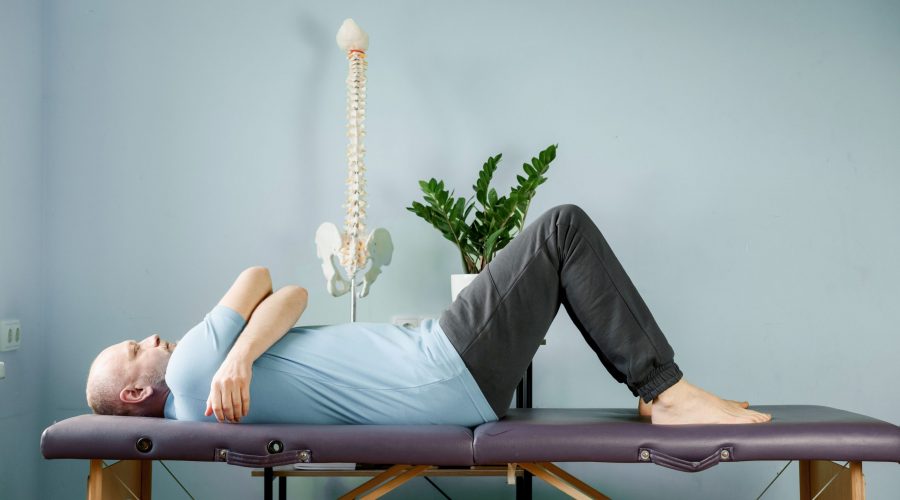Chronic joint stiffness, headaches, and mental tension have become common due to sitting for long periods, staring at smartphones, over-exertion at the gym, and chronic stress.
In this article, we explore the Alexander technique, an educational method that realigns your musculoskeletal system to help you live with more strength, ease, and balance.
Table of contents
- What is the Alexander Technique?
- The origins of the Alexander Technique?
- How does the Alexander Technique work?
- When and how is the Alexander Technique used?
- What is the evidence to support Alexander Technique?
- What to expect as an Alexander Technique student?
What is the Alexander technique?
The Alexander technique is a form of mind-body education that gives you awareness and control of your posture. Some people think of it as “mindfulness for the body.”
Practitioners help you unlearn bad habits – like poor posture, poor coordination and putting unnecessary strain on the muscles and joints. In doing so, you learn how to perform everyday activities with poise and stability.
The origins of the Alexander technique
An actor named Frederick Matthias Alexander developed the technique in the late 1800s after he discovered his poor posture on stage was causing chronic laryngitis.
By studying his posture in the mirror, he developed techniques to relieve tension and resolve his vocal troubles. After his success, he started helping other performers with his Alexander method.
Today, more than 60 years after his death, the Alexander technique is taught worldwide.
How does the Alexander technique work?
It’s normal to develop unnatural postures and movements over your life. For example, you may habitually tense your shoulders and extend your neck forward when working on your computer.
The Alexander technique helps you notice how you hold and move your body. This directly addresses the cause of poor posture.
Regular lessons teach you to sit, stand, walk, eat, and talk in a way that exerts as little force as possible. It saves you energy by improving “neuromuscular organisation.”
Moving more efficiently has knock-on effects on your overall health.
When and how is the Alexander Technique used?
The Alexander technique is popular among athletes, performers, singers, and dancers to enhance their physical performance, move with ease, and control their breath and voice.
That said, the principles of the Alexander technique can benefit anyone.
The Alexander technique is used in a range of situations
This technique isn’t a bodywork treatment in the conventional sense. It is an educational method that, when practised, becomes a way of life.
While it can’t cure any conditions, it may alleviate the following symptoms:
- Poor posture
- Voice strain
- Chronic musculoskeletal pain
- Tight chest and breathing problems
- Repetitive strain injuries
- Poor sleep
- Stress and anxiety
- Headaches
- Poor balance and coordination
- Symptoms of neuromuscular disorders
- Brain fog and poor focus
- Fatigue
- Vertebral degeneration
- Pain associated with pregnancy
These exercises help you feel taller, lighter, more relaxed, and more confident.
What is the evidence to support Alexander Technique?
A few small studies have found the Alexander technique, when compared to conventional care, may significantly reduce neck1 and back pain2. It may also have benefits for people with Parkinson-related disabilities, though more research is required and we recommend you speak with your GP before arranging an appointment3.
In musicians, the Alexander technique may reduce performance anxiety4.
What to expect as an Alexander technique student
The Alexander technique is not a passive bodywork therapy nor a form of repetitive exercise. It’s taught in private sessions with gentle, hands-on support and verbal feedback.
Alexander technique lessons
The teacher will begin by assessing your posture and seeing how you hold your body when standing, walking, sitting at a table, lying down, and getting in and out of a chair. They may also look at how you dance, sing, or play an instrument if necessary.
Throughout the session, you’ll learn to recognise when you’re holding your body in a tense way. The teacher will gently guide you to adjust your posture and improve your balance and coordination.
The goal is to exert as little energy as possible while doing simple activities like sitting, standing, and walking. You may also work on specific issues such as public speaking, playing sport, carrying heavy equipment, working at the computer, or sleeping.
An Alexander technique lesson usually lasts 30-45 minutes. At the end of the session, your teacher will discuss any homework to do between sessions.
Alexander technique exercises
Here are two general Alexander technique exercises.
Standing Up
Relax your neck and allow your spine and back to sink into the chair. You want your muscles to feel relaxed and free from tension. Next, move your feet close together and bend forward from your hips. Push your weight into your feet as you push up off the floor into a standing position.
The “Ahh” breath
This is a technique that can release tension in the jaw and neck.
– Inhale slowly through your nose with your lips closed and your teeth slightly apart to relax the jaw
– Open your jaw wide as you breathe out, making an “ahh” sound
– Ensure your shoulders are relaxed
How do I find an Alexander Technique practitioner, and what qualifications should they have?
Teachers must complete three years of Alexander technique training to become certified. However, there are no laws governing the practice.
Your teacher should register with a professional body to ensure they meet the highest standards for training, comply with a code of ethics, and engage in continual professional development (CPD).
Examples of such professional regulatory bodies include:
- Society of Teachers of the Alexander Technique (STAT)
- The Professional Association of Alexander Teachers
- Alexander Technique International (ATI)
- Complementary and Natural Healthcare Council (CHNC)
Search our Treatwiser directory to find an experienced Alexander Technique teacher in your area.
How much will it cost?
Some NHS trusts offer the Alexander technique to chronic pain patients. You can ask your doctor for a referral if this is available in your area.
Otherwise, private one-on-one lessons typically cost between £35-£70. Practitioners may offer a bulk rate if you pay for a block of sessions.
Alternatively, Alexander technique teachers may guide group workshops at a cheaper rate.
How many appointments will I need?
Practitioners often recommend between 10 and 30 sessions to retrain your mind and body. Ideally, the first 3-5 sessions should be close together as your brain rewires new neural pathways and your body learns to move more efficiently.
You may notice improvements quickly, but these techniques require commitment and consistency to maintain the benefits.
What are the risks associated with the Alexander technique?
The Alexander technique is a risk-free complementary therapy that isn’t strenuous and involves no manipulation.
However, it’s not a replacement for conventional medical treatment.
What do other patients say about the Alexander technique?
Read some testimonials to hear what patients are saying about their Alexander technique experiences:
Resources
- MacPherson et al. (2015). Alexander Technique Lessons or Acupuncture Sessions for Persons With Chronic Neck Pain: A Randomized Trial. Ann Intern Med.
- Hafezi et al. (2022). The effect of the Alexander Technique on pain intensity in patients with chronic low back pain: A randomized controlled trial. J Bodyw Mov Ther.
- Stallibrass et al. (2002). Randomized controlled trial of the Alexander technique for idiopathic Parkinson’s disease. Clin Rehabil.
- Klein et al. (2014). The Alexander Technique and musicians: a systematic review of controlled trials. BMC Complement Altern Med.
DISCLAIMER: The Site cannot and does not contain medical / health advice. The medical / health information is provided for general informational and educational purposes only and is not a substitute for professional advice. Accordingly, before seeking any form of medical advice, diagnoses or treatment based upon such information, we encourage you to consult with your GP or other qualified health practitioner. You must never disregard professional medical advice or delay in seeking it because of something mentioned on this Site. The use or reliance of any information contained on the Site is solely at your own risk.





